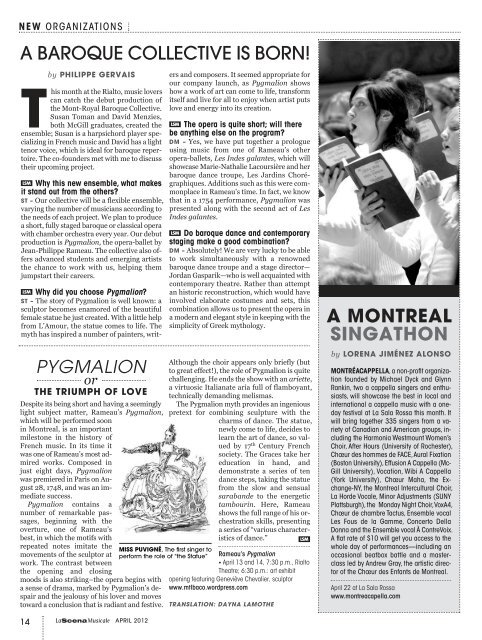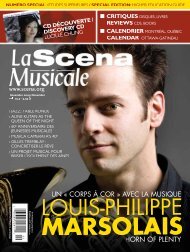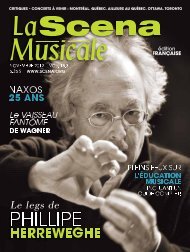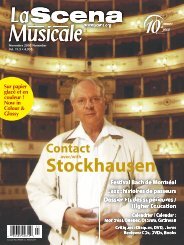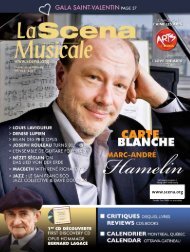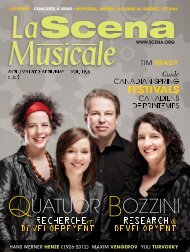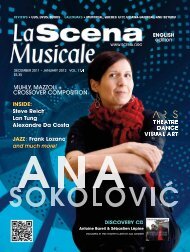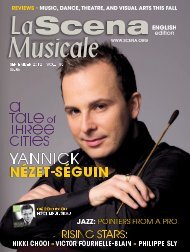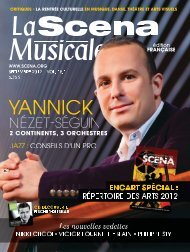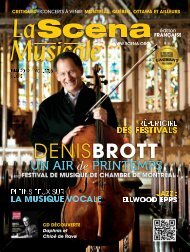The Bohlen-Pierce system - La Scena Musicale
The Bohlen-Pierce system - La Scena Musicale
The Bohlen-Pierce system - La Scena Musicale
Create successful ePaper yourself
Turn your PDF publications into a flip-book with our unique Google optimized e-Paper software.
NEW ORGANIZATIONS<br />
A BAROQUE COLLECTIVE IS BORN!<br />
by PHILIPPE GERVAIS<br />
This month at the Rialto, music lovers<br />
can catch the debut production of<br />
the Mont-Royal Baroque Collective.<br />
Susan Toman and David Menzies,<br />
both McGill graduates, created the<br />
ensemble; Susan is a harpsichord player specializing<br />
in French music and David has a light<br />
tenor voice, which is ideal for baroque repertoire.<br />
<strong>The</strong> co-founders met with me to discuss<br />
their upcoming project.<br />
LSM Why this new ensemble, what makes<br />
it stand out from the others?<br />
ST – Our collective will be a flexible ensemble,<br />
varying the number of musicians according to<br />
the needs of each project. We plan to produce<br />
a short, fully staged baroque or classical opera<br />
with chamber orchestra every year. Our debut<br />
production is Pygmalion, the opera-ballet by<br />
Jean-Philippe Rameau. <strong>The</strong> collective also offers<br />
advanced students and emerging artists<br />
the chance to work with us, helping them<br />
jumpstart their careers.<br />
PYGMALION<br />
or<br />
THE TRIUMPH OF LOVE<br />
Despite its being short and having a seemingly<br />
light subject matter, Rameau’s Pygmalion,<br />
which will be performed soon<br />
in Montreal, is an important<br />
milestone in the history of<br />
French music. In its time it<br />
was one of Rameau’s most admired<br />
works. Composed in<br />
just eight days, Pygmalion<br />
was premiered in Paris on August<br />
28, 1748, and was an immediate<br />
success.<br />
Pygmalion contains a<br />
number of remarkable passages,<br />
beginning with the<br />
overture, one of Rameau’s<br />
best, in which the motifs with<br />
repeated notes imitate the<br />
movements of the sculptor at<br />
work. <strong>The</strong> contrast between<br />
the opening and closing<br />
moods is also striking–the opera begins with<br />
a sense of drama, marked by Pygmalion’s despair<br />
and the jealousy of his lover and moves<br />
toward a conclusion that is radiant and festive.<br />
MISS PUVIGNÉ, <strong>The</strong> first singer to<br />
perform the role of “the Statue”<br />
LSM Why did you choose Pygmalion?<br />
ST – <strong>The</strong> story of Pygmalion is well known: a<br />
sculptor becomes enamored of the beautiful<br />
female statue he just created. With a little help<br />
from L’Amour, the statue comes to life. <strong>The</strong><br />
myth has inspired a number of painters, writers<br />
and composers. It seemed appropriate for<br />
our company launch, as Pygmalion shows<br />
how a work of art can come to life, transform<br />
itself and live for all to enjoy when artist puts<br />
love and energy into its creation.<br />
LSM <strong>The</strong> opera is quite short; will there<br />
be anything else on the program?<br />
DM – Yes, we have put together a prologue<br />
using music from one of Rameau’s other<br />
opera-ballets, Les Indes galantes, which will<br />
showcase Marie-Nathalie <strong>La</strong>coursière and her<br />
baroque dance troupe, Les Jardins Chorégraphiques.<br />
Additions such as this were commonplace<br />
in Rameau’s time. In fact, we know<br />
that in a 1754 performance, Pygmalion was<br />
presented along with the second act of Les<br />
Indes galantes.<br />
LSM Do baroque dance and contemporary<br />
staging make a good combination?<br />
DM – Absolutely! We are very lucky to be able<br />
to work simultaneously with a renowned<br />
baroque dance troupe and a stage director—<br />
Jordan Gasparik—who is well acquainted with<br />
contemporary theatre. Rather than attempt<br />
an historic reconstruction, which would have<br />
involved elaborate costumes and sets, this<br />
combination allows us to present the opera in<br />
a modern and elegant style in keeping with the<br />
simplicity of Greek mythology.<br />
Although the choir appears only briefly (but<br />
to great effect!), the role of Pygmalion is quite<br />
challenging. He ends the show with an ariette,<br />
a virtuosic Italianate aria full of flamboyant,<br />
technically demanding melismas.<br />
<strong>The</strong> Pygmalion myth provides an ingenious<br />
pretext for combining sculpture with the<br />
charms of dance. <strong>The</strong> statue,<br />
newly come to life, decides to<br />
learn the art of dance, so valued<br />
by 17 th Century French<br />
society. <strong>The</strong> Graces take her<br />
education in hand, and<br />
demonstrate a series of ten<br />
dance steps, taking the statue<br />
from the slow and sensual<br />
sarabande to the energetic<br />
tambourin. Here, Rameau<br />
shows the full range of his orchestration<br />
skills, presenting<br />
a series of “various characteristics<br />
of dance.”<br />
Rameau’s Pygmalion<br />
• April 13 and 14, 7:30 p.m., Rialto<br />
<strong>The</strong>atre; 6:30 p.m.: art exhibit<br />
opening featuring Geneviève Chevalier, sculptor<br />
www.mtlbaco.wordpress.com<br />
TRANSLATION: DAYNA LAMOTHE<br />
LSM<br />
A MONTREAL<br />
SINGATHON<br />
by LORENA JIMÉNEZ ALONSO<br />
MONTRÉACAPPELLA, a non-profit organization<br />
founded by Michael Dyck and Glynn<br />
Rankin, two a cappella singers and enthusiasts,<br />
will showcase the best in local and<br />
international a cappella music with a oneday<br />
festival at <strong>La</strong> Sala Rossa this month. It<br />
will bring together 335 singers from a variety<br />
of Canadian and American groups, including<br />
the Harmonia Westmount Women’s<br />
Choir, After Hours (University of Rochester),<br />
Chœur des hommes de FACE, Aural Fixation<br />
(Boston University), Effusion A Cappella (Mc-<br />
Gill University), Vocation, Wibi A Cappella<br />
(York University), Chœur Maha, the Exchange-NY,<br />
the Montreal Intercultural Choir,<br />
<strong>La</strong> Horde Vocale, Minor Adjustments (SUNY<br />
Plattsburgh), the Monday Night Choir, VoxA4,<br />
Chœur de chambre Tactus, Ensemble vocal<br />
Les Fous de la Gamme, Concerto Della<br />
Donna and the Ensemble vocal À ContreVoix.<br />
A flat rate of $10 will get you access to the<br />
whole day of performances—including an<br />
occasional beatbox battle and a masterclass<br />
led by Andrew Gray, the artistic director<br />
of the Chœur des Enfants de Montreal.<br />
April 22 at <strong>La</strong> Sala Rossa<br />
www.montreacapella.com<br />
14<br />
APRIL 2012


